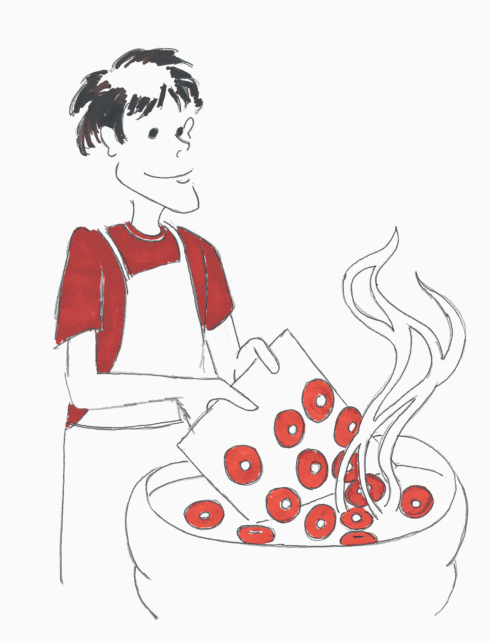In the third chapter of The Bird that Sang in Color, Donna challenges Vincent’s decision to accept a baking job, saying that he could do so much more. About a week later, she tastes homemade bread that he baked and marvels and “how four simple ingredients could become something so rich, complex, and wonderful.” This is a metaphor for Vincent who is simple but yet wonderfully complex.
When she sees the sketch of him baking donuts, she remembers the joy that he got from this job. “He was wearing a red shirt, a white apron, and a big, goofy closed-lip smile that made me remember how happy he was as a baker.” This is telling of her transformation as she begins to see that happiness is subjective and that, while many people might not like such a vocation as baking, her brother did and it was something in which he took great pride.
The following scene is from Chapter Three of The Bird that Sang in Color.
That night around six, Mom and I were in the kitchen finishing up the dishes when Vincent came through the back door smiling, holding a white paper bag like there was some great treasure in it.
“I got some fresh-baked bread I made,” he said, his eyes gleaming with pride.
“Fresh-baked bread!” Mom said as she opened the refrigerator and got out some butter. “You made it?” Delight floated in her voice like a cherub bouncing from cloud to cloud.
“Yeah,” he said, sitting down at the table, still smiling.
“Oh yum,” I said, sitting down. “Let’s crack into it.”
Mom put a cutting board and two knives on the table—one to cut the bread and one to spread the butter. Then, she placed the bread on top of the cutting board like it was a priceless sculpture and called it a work of art. I cut into the center, feeling the slightest bit of warm steam on my hand. The heat of the bread softened the butter making it spreadable. The crust was soft, and the inside even softer and warm and with butter, it was truly divine—not just my taste buds playing tricks on me because I was on love-sick cloud nine. Mom and I couldn’t stop telling him how delicious it was and talking about it as if it was some new state-of-the-art invention.
“How did you make it?” I said, buttering my second slice.
“Oh boy,” he said, taking a big sigh. “First, I make the biga yeast the night before.”
“Biga?” I said. “Never heard of that.”
“Oh yeah. You make it with yeast, flour, and water. You gotta let that rise overnight. The next morning, you make the dough, and let it rise like four or five hours.”
“What if you get it too soon or too late?” I asked.
“Then, you make a lousy loaf,” he said, laughing. “Anyway, it’s really cool, just waiting for it to be ready.” That would drive me crazy. I couldn’t stand waiting for things to happen.
“What do you make the dough from?” Mom said.
“The biga yeast, water, salt, and more yeast,” he said, having one of his massive-sized bites of bread.
“How long does it take to bake?” I said.
“Just like twenty minutes.”
He really seemed to like talking about making bread, so I asked some more questions. I asked him about the other kinds of bread he made, which ones were most popular, and about the history of breadmaking. He said he also made rye, raisin, and baguettes, and said baguettes were by far the most popular. He said bread started being made in 300 BC. All the while, I listened, my mind spun, trying to understand how four simple ingredients could become something so rich, complex, and wonderful.
He talked on about the bakery and all the other stuff he’d be making eventually—pies, doughnuts, cakes, pastries. We listened contentedly while polishing off the entire loaf. There was a quiet that rarely, if not ever, lived within our house. Outside our window, it was dark and cold, but inside, it was all light and warmth, and in that moment, I understood, fully and deeply, what Mom loved about Christmas.
This post is part of my latest blog series on the artwork that inspired the family saga, The Bird that Sang in Color. The art featured in these posts comes from a sketchbook that belonged to my brother, Vincent, which I discovered shortly after his death. It had pictures he’d drawn of himself throughout various phases of his life. This pictorial autobiography caused me to wonder what pictures I’d have of myself by the end of my life, which motivated me to live more fully. In writing this novel, I was able to share this powerful realization with the world. This novel is the third book in the Greco Family Trilogy. Each one of these family trilogy books is told from a different family member’s point of view. This one is told from the perspective of the Greco family matriarch, Donna.
Grace Mattioli is the author of the Greco Family Trilogy books, including Olive Branches Don’t Grow on Trees, Discovery of an Eagle, and The Bird that Sang in Color. These books are available from all major online book sellers, including Amazon, Barnes & Noble, and Apple Books.




